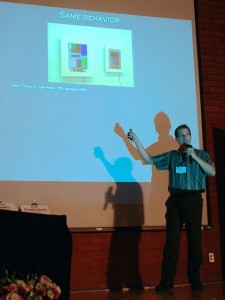 Professionals across the spectrum of cultural heritage institutions are struggling to keep up with an increasingly digital landscape, as confirmed by the 30-odd contributions to Mexico’s first Symposium on Audiovisual and Digital Archiving (SIPAD). Today’s curators and conservators have their hands full coping with constantly changing video formats and Web standards, not to mention convincing legislators and administrators to support the enormous effort and time required to bring collections into the 21st century.
Professionals across the spectrum of cultural heritage institutions are struggling to keep up with an increasingly digital landscape, as confirmed by the 30-odd contributions to Mexico’s first Symposium on Audiovisual and Digital Archiving (SIPAD). Today’s curators and conservators have their hands full coping with constantly changing video formats and Web standards, not to mention convincing legislators and administrators to support the enormous effort and time required to bring collections into the 21st century.
On the eve of Mexico’s famous Day of the Dead, a handful of presenters at this event organized by at the National Institute of Anthropology and History suggested that a solution for exhausted professionals may come from unexpected sources. In his concluding keynote for the week-long conference, Still Water co-director Jon Ippolito urged professionals to learn from the surprising successes of amateurs in rescuing artifacts that would otherwise have been lost to obsolescence.
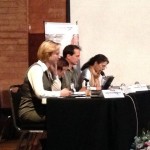 Ippolito cited examples of crowdsourcing that range from creating emulators and simulating ancient hardware, to re-creating deteriorating artifacts with 3d printing and re-establishing control over errant spacecraft. His keynote was drawn from Re-collection: Art, New Media, and Social Memory, a book co-authored by curator Richard Rinehart just published this summer by MIT Press.
Ippolito cited examples of crowdsourcing that range from creating emulators and simulating ancient hardware, to re-creating deteriorating artifacts with 3d printing and re-establishing control over errant spacecraft. His keynote was drawn from Re-collection: Art, New Media, and Social Memory, a book co-authored by curator Richard Rinehart just published this summer by MIT Press.
Ippolito was also quoted in the October 19th New York Times about a tool for preserving social media developed by one of the other conference participants, Dragan Espenschied. Espenschied’s tool “puts the ability to capture data back in the hands of the individuals,” Ippolito said. “The user is in the driver’s seat, instead of the social network that now owns that user’s information.”
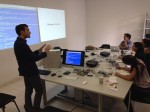 In Mexico City, Espenschied demo’d the bwFLA browser-based emulator that he helped develop, quipping that “I like hardware, but it’s got to go.” In the bwFLA emulator, users can download any needed software directly in the emulated browser. Another popular demo came from Ben Fino-Radin, who showed how to use forensic tools like FTK Imager and write blockers, which Fino-Radin called “the white gloves of digital preservation.”
In Mexico City, Espenschied demo’d the bwFLA browser-based emulator that he helped develop, quipping that “I like hardware, but it’s got to go.” In the bwFLA emulator, users can download any needed software directly in the emulated browser. Another popular demo came from Ben Fino-Radin, who showed how to use forensic tools like FTK Imager and write blockers, which Fino-Radin called “the white gloves of digital preservation.”
Also presenting on the topic of crowdsourcing in the context of adding metadata to online collections were Julia Noordegraaf and Johan Oomen, who reported mixed success with inviting the public to tag birds in video and sound archives. Noordegraaf cautioned that crowdsourcing metadata may not improve collection records as much as it improves the engagement of a museum with its audience.
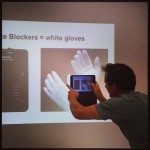 Oomen showed two crowdsourcing successes: Sound of the Netherlands, in which the public added to a map audio recordings hosted with SoundCloud, eliciting comments like “I’ve been there!” Oomen also demo’d the AXES project, which lets users search a German video archive visually–for example, by looking for faces, eyeglasses, or similarity to uploaded images. For organizations putting content online, Oomen asked, “how can our content go where users are rather than expect them to come to us?” For his part, the Internet Archive’s Jason Scott described the crowdsourced Web archiving project Archive Team Warrior as “a distributed preservation of service attack, with a leaderboard.”
Oomen showed two crowdsourcing successes: Sound of the Netherlands, in which the public added to a map audio recordings hosted with SoundCloud, eliciting comments like “I’ve been there!” Oomen also demo’d the AXES project, which lets users search a German video archive visually–for example, by looking for faces, eyeglasses, or similarity to uploaded images. For organizations putting content online, Oomen asked, “how can our content go where users are rather than expect them to come to us?” For his part, the Internet Archive’s Jason Scott described the crowdsourced Web archiving project Archive Team Warrior as “a distributed preservation of service attack, with a leaderboard.”
Presenter Bruno Bachiment argued that digital convergence reinforces the authentic identity sought after by archives, but diverging publication platforms (Web/PDF/ebook/tablet/phone) jeopardize it. Bachiment identified empathy as key to interpreting the past, with the implication that archives must be processes, not inert collections. As an example of a memory process, Bachiment argued that Etruscans left intact sculpture but no remembrance, while Aristotle left no manuscripts but a robust, millennia-old tradition of debating his ideas.
 The symposium was organized by conservators Nadine Vera and Jo Ana Morfin, who also introduced attendants to innovative analog projects associated with the National Institute of Anthropology and History. In a local Mexican example of community-based preservation, conservator Lorena Roman grows orchids outside the conservation lab at the National School of Conservation, Restoration, and Museography to harvest resin to serve as binder to line deteriorating tapestries. Her students work with indigenous communities to learn how to use a loom and natural dyes–and in the process discover that these users want their saints to look new!
The symposium was organized by conservators Nadine Vera and Jo Ana Morfin, who also introduced attendants to innovative analog projects associated with the National Institute of Anthropology and History. In a local Mexican example of community-based preservation, conservator Lorena Roman grows orchids outside the conservation lab at the National School of Conservation, Restoration, and Museography to harvest resin to serve as binder to line deteriorating tapestries. Her students work with indigenous communities to learn how to use a loom and natural dyes–and in the process discover that these users want their saints to look new!
Photo conservation in the digital age was the topic of a workshop Ippolito held with conservator Fernanda Valverde’s class. Before there were digital scanners, Valverde repurposed an opacity detector from an astrophysics lab to digitize photos. For his part, Ippolito asked how historians would preserve selfies, whose meaning is tied up less in their pictorial qualities than in the moment they are meant to share with others. Storing the photo isn’t enough–you have to capture their social network.
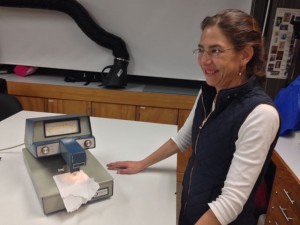 In his concluding keynote, Ippolito also showed 3d scans of sculptural artifacts made by the University of Maine’s Digital Curation students as another example of crowdsourcing preservation, including the scan of an Aztec puma he made on the spot at Mexico City’s Templo Major. UMaine’s Digital Curation program is an all-online graduate certificate recommended for archivists, librarians, curators, and anyone else who manages digital files.
In his concluding keynote, Ippolito also showed 3d scans of sculptural artifacts made by the University of Maine’s Digital Curation students as another example of crowdsourcing preservation, including the scan of an Aztec puma he made on the spot at Mexico City’s Templo Major. UMaine’s Digital Curation program is an all-online graduate certificate recommended for archivists, librarians, curators, and anyone else who manages digital files.

Still Water blog · Day of the Dead (Media): how aficionados can help revive dying culture http://t.co/cNKJHeipBA
Dennis Moser liked this on Facebook.
RT @stillwaternet: Day of the Dead (Media): how aficionados can help revive dying culture #DigPres #DigitalPreservation http://t.co/SDHlF4G…